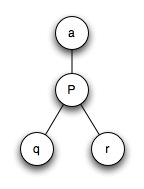SoniaSandbox: Difference between revisions
| Line 78: | Line 78: | ||
We ask, what is the probability of ''each'' mutation occuring along a branch of a certain length? What is the probability that they ALL occurred, to give us the sequences we see today? | We ask, what is the probability of ''each'' mutation occuring along a branch of a certain length? What is the probability that they ALL occurred, to give us the sequences we see today? | ||
[[Image:Topology distance.jpg|right]] | |||
[[Image:Topology distance.jpg]] | |||
<blockquote><tt> | <blockquote><tt> | ||
p(D|T) = p(x->A|d_1) * p(x->y|d_2) * p(y->G|d_3) * p(y->G|d_4) | p(D|T) = p(x->A|d_1) * p(x->y|d_2) * p(y->G|d_3) * p(y->G|d_4) | ||
Revision as of 08:29, 4 October 2006
Temp notes for Lecture 7
quick comment on upPass

- not a popular algorithm
- (you won't be tested on it)
- but here's the correct way to do it:
- (from Peter Beerli's website)
Fx: the upPass set we want to get to
Sx: the downpass set we got to
ancestor = a
parent = p, node we're looking at
children = q,r
Revisit overall strategy
- Although up until now we've always started with a tree of known topology, a lot of times you wouldn't know the tree topology beforehand
for all possible trees:
- compute score (tree)
return best tree
Scoring functions
- max parsimony (fewest mutations)
- generalized parsimony (Sankoff: weighted mutation costs)
- Maximum Likelihood
ML intro
- examples of a ML estimator:
- for normally distributed random var X, X(bar), the mean of the data you observe, is a ML estimator of the mean of the distribution they were drawn from
- A best fit line thru data is a ML estimator.
Probability Refresher

total area of a box = 1
p(A)= 0.3 , p(B)= 0.3
p(A,B)= 0.1
p(A|B)= 0.1 / (0.1+0.2) = 1/3 = p(A,B) / p(B)
p(B|A) = 0.1 / (0.1+0.2) = p(A,B) / p(A)
With a little manipulation we can derive Bayes' Rule:
p(A|B) = p(B|A) * p(A) / p(B)
ML in trees
- We are looking for the best tree, given some data. What is the best tree T given the data D?
- p(T|D) is what we want to maximize
- Not obvious how we want to do that... use Bayes Law to rearrange into something we can intuitively understand
p(T|D) = p(D|T) * p(T) / p(D)
- p(D) is a constant ... we don't have to worry about it
- What is p(T), the a priori probability of the tree ?
- Well, without looking at the data, do we have a way of saying any tree is more likely than another one if they don't have any data associated with them ?
- No... not really
- So what we're left maximizing is just p(D|T) and that sounds like a familiar concept!
NOTE: Tree now consists of topology AND distances We ask, what is the probability of each mutation occuring along a branch of a certain length? What is the probability that they ALL occurred, to give us the sequences we see today?

p(D|T) = p(x->A|d_1) * p(x->y|d_2) * p(y->G|d_3) * p(y->G|d_4)
p(A U B) = p(A) + p(B) - p(A,B)
p(A <intersect> B) = p(A)*p(B)
- We treat all of these mutations along the different branches as independent events (that's why you multiply the probabilities, because all the events have to happen independently.)
Jukes-Cantor
based on a simple cost matrix probability of changing from one particular nucleotide to another particular nucleotide is 'a' probability of any nucleotide staying the same is '1-3a'
if x == y :
- [JC eqn you'll derive in the hw]
if x != y :
- [JC eqn you'll derive in the hw]
Evolutionary Model
gives us likelihood of (D|T) (need branch lengths)
downPass for ML
- compute L(p|q,r,d)
q , r = likelihood of the two subtrees, d is the distance to them (?)
Temp notes for Lecture 6
Exams and HWs
- In-class midterm on 10/11
- studying for the exam:
- don't memorize lecture notes,
- more important to be able to work through the problems
- understand all the homeworks and you'll be prepared
Homeworks coming up
- HW5: Due next wednesday
- downPass, maximum likelihood
- HW6:
- search tree space
Up Pass
- If we know what the best answer is at the root- all of out other internal nodes aren't necessarily the best guess. We need an upPass algorithm that passes information from the root, back up to the leaves.
- For this example, we are dealing with one column of the sequence alignment
def upPass(tree,parent):
- if tree is a leaf: #(stop)
- return
- i123 = parent <intersect> left <intersect> right
- i12 = left <intersect> right
- i23 = parent <intersect> left
- i13 = parent <intersect> right
- if i123 != None:
- tree['data'] = i123
- else: #possible to simplify if empty set doesn't add with +=
- if i12 != None:
- data += i12
- if i13 != None:
- data += i13
- if i23 != None:
- data += i23
- if data == None:
- data = parent + left + right # union here
- tree['data']= data
- We are doing this for the most general case, where we considered:
- what should we do when there is no intersect ?
- When you start upPass that can't be the case because every parent should have an interset with its children if you've done downPass correctly....BUT this situation does arise as you traverse up the tree because you eliminate possibilities at a parent before you test for intersect with the children.

